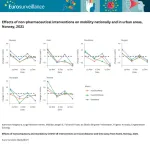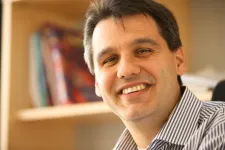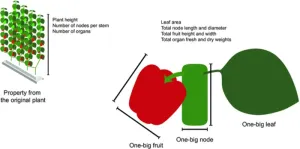(Press-News.org)
Inflammation is a complex biological process that can eradicate pathogens and promotes repair of damaged tissues. However, deregulation of the immune system can lead to uncontrolled inflammation and produce lesions instead. Inflammation is also involved in cancer. The molecular mechanisms underlying inflammation are not fully understood, and so developing new drugs represents a significant challenge.
As far back as 2020, Dr. Raphaël Rodriguez, CNRS research director and head of the Chemical Biology team at Institut Curie (Equipe Labellisé Ligue Contre le Cancer) at the Cellular and Chemical Biology laboratory (Institut Curie/CNRS/Inserm), had shed new light on a membrane receptor called CD44, which marks immune responses, inflammation and cancer progression. Dr. Rodriquez and his team showed that CD44 helped import iron into cell[1], triggering a series of reactions leading to activation of genes involved in the metastatic process. “This is a cell plasticity phenomenon we continued to study, investigating other metals potentially internalized by CD44, notably copper,” he explains.
Copper causing epigenetic alterations
Along with his colleagues[2], Dr. Rodriguez has now reached a new milestone. The research team managed to identify a signaling pathway involving copper and leading to the expression of pro-inflammatory genes in macrophages, the cells present in all tissues and playing an important role in innate immunity.
Once internalized in macrophages, copper enters into the mitochondria (the organelle responsible for cell respiration and energy production), where it catalyzes the oxidation of NADH into NAD+ (nicotinamide adenine dinucleotide, a molecule needed for the activity of certain enzymes). The increase of NAD+ in cells enables the activity of certain enzymes involved in the production of metabolites essential for epigenetic regulation. These metabolites thus, contribute to the activation of genes involved in inflammation.
Inflammation and cancer: shared molecular mechanisms
The scientists did not stop there, they also designed molecules able to bind to copper, inspired from the structure of metformin.[3] By testing these new molecules on models of acute inflammation, they found that a synthetic dimer of metformin, LCC-12 (also termed Supformin), reduced activation of macrophages and attenuated inflammation. “Our work has enabled us to develop a drug prototype that inactivates copper chemistry in the cell’s metabolic machinery, thus blocking expression of the genes involved in inflammation”, explains Dr. Rodriguez.
To finish, they applied this therapeutic strategy to cancer cell models engaged in an epithelial-mesenchymal transition[4]. Here again, Supformin blocked the cellular mechanism and thus the cell transformation. “The genes activated in cancer cells are not the same as those expressed in immune cells, but the chain reaction leading to epigenetic alterations is identical”, explains Rodriguez. These results thus reveal the role of copper in cancer cells and their ability to adopt a metastatic nature.
Dr. Raphaël Rodriguez concludes: “Our study reveals that the inflammatory and cancer processes depend on similar molecular mechanisms and could therefore in the future benefit from similar innovative therapies, such as those tested with Supformin.”
Notes
[1] Read the press release “Cancer: a new mechanism that regulates cell activity involving iron”: https://curie.fr/sites/default/files/medias/documents/2020-08/CPCNRS-CD44ferCancer-FR-emb.pdf
[2] This study was conducted at Institut Curie, in the Cellular and Chemical Biology unit (Institut Curie, CNRS, Inserm), in collaboration with UVSQ, Raymond Poincaré hospital (AP-HP), Gustave Roussy hospital, the Institut de chimie moléculaire et des matériaux d’Orsay (CNRS/University Paris-Saclay), the Multimodal Imaging Center (CNRS/Institut Curie/Inserm/University Paris-Saclay), the Center for Infection and Immunity of Lille (CNRS/Inserm/Institut Pasteur de Lille/CHU of Lille/University of Lille), Institute of Pharmacology and Structural Biology (CNRS/University of Toulouse III) along with British and Australian researchers.
[3]Metformin is a treatment used for Type-2 diabetes, and is able to form a bimolecular complex with copper.
[4] Epithelial-mesenchymal transition is the first step in enabling cancer cells to metastasize.
END
A research team led by Prof. HYEON Taeghwan at the Center for Nanoparticle Research within the Institute for Basic Science (IBS) in Seoul, South Korea has developed a new photocatalytic platform for the mass production of hydrogen. The group’s study on the photocatalytic platform led to the development of a floatable photocatalytic matrix, which allows efficient hydrogen evolution reaction with clear advantages over conventional hydrogen production platforms such as film or panel types.
The importance of alternative energy has recently increased due to global challenges such as environmental ...
FOR IMMEDIATE RELEASE
Researchers at Johns Hopkins University School of Medicine say they have evidence from a new study in rats that spinal cord stimulation (SCS) may be useful in reducing chronic pain in people undergoing active treatment with a common anti-cancer drug.
The study found that the use of SCS measurably reduced pain response in rats that were implanted with human lung cancer tissue — without compromising effectiveness of treatment with paclitaxel, a drug used to treat a variety of cancers.
The study, published April 11 in Neuromodulation: Technology at the Neural ...
Norway, like other Nordic countries, widely utilised non-mandatory advice during the COVID-19 pandemic in the attempt to reduce social contacts among people and occasionally turned to obligatory measures, specifically during peaks in transmission. In comparison with stricter interventions, non-mandatory measures are usually less invasive and costly and have been recommended in previous pandemics, including influenza.
Mobile phone data provides mobility metrics
In their research article published in Eurosurveillance today, Kamineni et al. compare the impact on mobility when previously non-mandatory ...
WASHINGTON — New and advanced types of nuclear reactors could play an important role in helping the U.S. meet its long-term climate goals, but a range of technical, regulatory, economic, and societal challenges must first be overcome, says a new report from the National Academies of Sciences, Engineering, and Medicine. Development, testing, and widespread deployment of these reactors could take several decades. The report makes recommendations for the U.S. Department of Energy, the Nuclear Regulatory Commission, other federal and state agencies, and private industry to lay the groundwork required for advanced reactors to become a viable part of the U.S. energy system.
Currently, ...
A plant-based compound purified from the traditional Chinese herb, Astragalus, has the potential to improve the outcome of heart attack patients, new research has revealed.
Experts at Newcastle University, UK, have found that the product, known as TA-65®, significantly reduces inflammation and, unlike current cardiovascular treatments, does not negatively impact immunity.
A study, published in GeroScience, showed that when TA-65® was given to older patients for over a year after their heart attack, it specifically increased lymphocytes, improving immunity ...
TORONTO, April 27, 2023 – Families of those with serious mental health issues feel stigmatized and alone, say York University researchers in a new study.
“We are avoided. When we told our family, they shut us out, I am so hurt, and so angry” – 62-year-old mom with an adult son with serious mental illness, as described to York researchers.
It’s well known that those who have serious mental illnesses such as schizophrenia face a great deal of stigma in society, but what has been less understood is the concept of “stigma by ...
The 819-day calendar used by ancient Mayans has long stumped researchers, but anthropologists from Tulane University may have finally deciphered its secrets.
Researchers long suspected the calendar followed astronomical events, specifically how long it takes a planet to appear in the same place in the night sky as seen from Earth, known as the synodic periods of planets. But, according to the study published in Ancient Mesoamerica, the cycles in the Maya calendar cover a much larger timeframe than scholars previously thought.
“Although prior research has sought to show planetary connections for the 819-day count, its four-part, color-directional scheme is too short to fit well with ...
Crop yield can be maximized when the best genetic variety and most effective crop management practices are used for cultivation. Scientists have developed various machine learning models to predict the factors that produce the greatest yield in specific crop plants. However, traditional models cannot accommodate high levels of variation in parameters or large data inputs. This can lead to the failure of models under certain circumstances. Also, since crop models are restricted to the types of input they can accommodate, ...
When manipulating an arcade claw, a player can plan all she wants. But once she presses the joystick button, it’s a game of wait-and-see. If the claw misses its target, she’ll have to start from scratch for another chance at a prize.
The slow and deliberate approach of the arcade claw is similar to state-of-the-art pick-and-place robots, which use high-level planners to process visual images and plan out a series of moves to grab for an object. If a gripper misses its mark, it’s back to the starting point, where the controller must map out a new plan.
Looking to give ...
Studies show that some species may require breeding in captivity within the next 200 years to avoid extinction. This reality places heavy importance on the reintroduction practices used to successfully transfer species from captivity to the wild. A new study from George Mason University looks at some of the most popular conservation techniques and identifies which have the highest likelihood of success for the reintroduction of bird species back into the wild.
George Mason doctoral student Jessica Roberts and biology professor Dr. David Luther examined various conservation management methods from the past 50 years to identify the most successful ...




